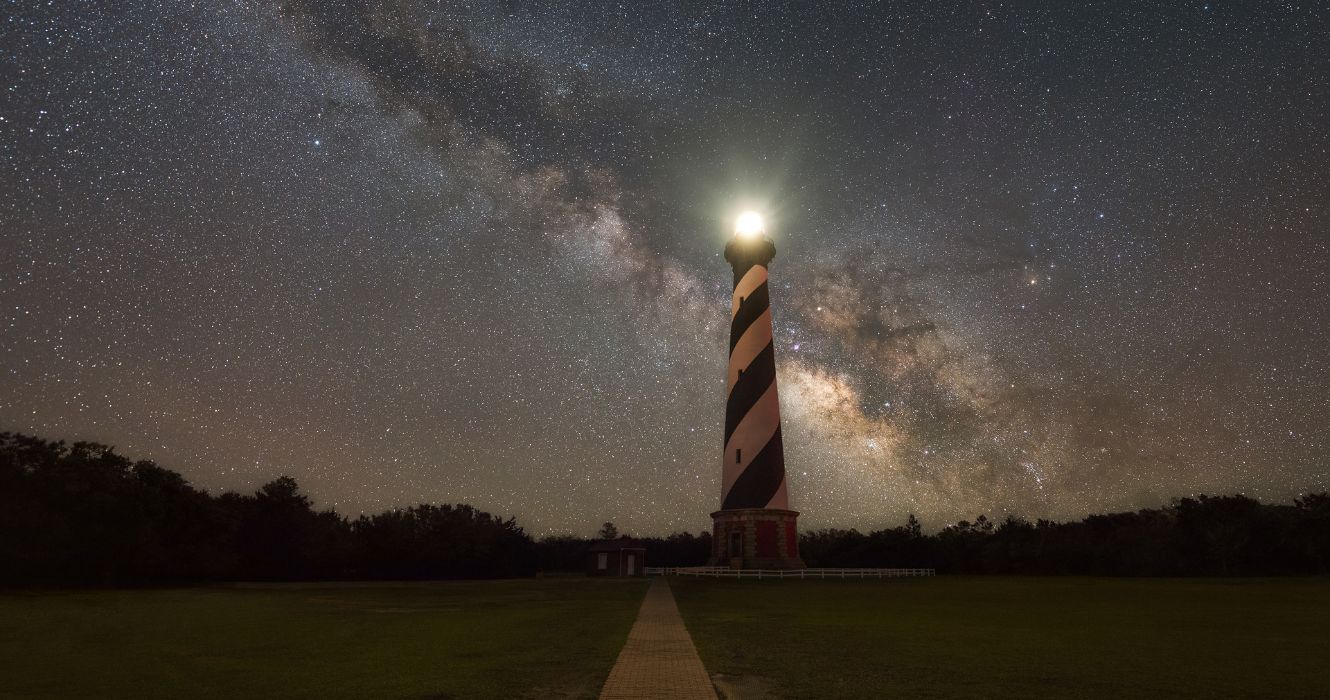Quick Links
Along the Outer Banks, a coastal region in North Carolina famous for its fine beaches and amazing campsites, is a region that has come to be known as the “Graveyard of the Atlantic.” Overlooking this region is a lighthouse that’s one of the most famous in the United States. There are many reasons the Cape Hatteras Lighthouse hogs the attention of many curious travelers. For starters, the Cape Hatteras Lighthouse is the tallest brick lighthouse in the United States.
That’s no easy feat. For perspective, the United States is home to about 700 lighthouses that peer gloomily over the iridescent waters on either side of her coast. Its height, from the base to the tower—stretches to an impressive 198.49 feet.
In this article, we reveal more about this historic lighthouse and the region it overlooks that has been rightly christened “The Graveyard of America.”
This Outer Banks Region Is Called The Graveyard Of The Atlantic
Five thousand. That’s the approximate minimum number of shipwrecks that have occurred in the Outer Banks region known as the Graveyard of America. Approximate—because the exact number is not even known with certainty.
And that’s without counting the human cost. Take the case of USS Monitor, an ironclad warship that was constructed for the Union Navy during the American Civil War. The previous ships had been wooden.
USS Monitor was constructed in haste and almost in a panic—when information reached union leaders that the rebel Confederates had been building an ironclad ship at Gosport, near Norfolk. The name of the Confederates’ ironclad ship was Virginia.
Moving against time, Union leaders embarked on a scheme to counter Virginia. The answer was USS Monitor. When USS Monitor arrived on the scene, Virginia had already destroyed some strategic Union ships in Hampton Roads, Virginia. There was now palpable fear that Virginia would sail the Potomac River and attack Washington.
It’s in this cloud of unease and restlessness that USS Monitor arrived on the scene in what would be the most definitive naval battle of the Civil War. The advance of Virginia towards Washington was halted and the Union snatched an unlikely draw from the jaws of defeat.
However, in December 1862, orders were issued for the USS Monitor to join other ships that were being assembled in Charleston. The ship found its way around Cape Hatteras where the rough waters of the ocean would prove fatal.
The ship started swaying like a reed. Within no time, water started leaking into the ship’s hull.
The ironclad’s pumps stopped working and the ship sank with 16 crew members. Unfortunately, this was not an isolated incident.
About 600 such incidents happened in the Hatteras Islands.
Way back in the 16th century, such incidents usually took place at a meeting point of the warm Gulf Stream—from the south—with the cold Labrador Current from the north.
The Original Cape Hatteras Lighthouse Was Erected In 1803
To try to limit the number of deaths taking place in these treacherous waters of the Atlantic, the construction of a lighthouse at Cape Hatteras was first approved in 1794. It would take another five years before construction would begin in earnest.
In 1803, the first lighthouse was completed. It was 90 feet tall and its source of light was whale oil. That was before kerosene—and way before electricity became sources of lighthouse light.
However, there was a problem. The lighthouse was so short that it wasn’t able to illumine diamond shoals, a cluster of shallow, underwater sandbars—thought to be responsible for many of the shipwrecks around Cape Hatteras.
As a result, in 1853, 50 feet were added to the structure, stretching it to 150 feet.
Seeing that the lighthouse was still falling short of expectations, Congress ordered the construction of a new one whose lights went up in December 1870. Subsequently, the old one would be demolished in less than two months.
The New Cape Hatteras Lighthouse Continues To Stand Watch
The conical shape of the lighthouse stands on top of an octagon-shaped substructure made of brick and granite. Its 198-feet height was necessary to project the light outwards to the ocean, especially since the beach site on which the tower stands is a bit low.
The distance from the lighthouse to the shoreline at the time it was built was about 457 meters. For those who can, climbing the 269 steps from the ground to the lens room—the equivalent of climbing the stairs of a 12-story building—is arduous.
However, the trek eventually gifts amazing 360-degree views that are some of the most breathtaking in the area.
- Is The Cape Hatteras Lighthouse Currently Open For Climbing? The Cape Hatteras Lighthouse is not currently open for climbing because it's undergoing some renovations.
- Normally, The Cape Hatteras Lighthouse Charges How Much For Climbing? Climbing tickets are $8 for adults and $4 for senior citizens (62 or older), and children (11 and under).
For those wondering when to go, the Cape Hatteras Lighthouse is open from the third Friday in April through Columbus Day in October.
That’s the story of the lighthouse that stands tall over the Graveyard of America. And because of its fame and history, it justly deserves a visit.

